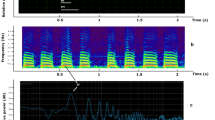Abstract
We have shown that D. busckiimales and females, unlike other drosophilids that have been analyzed in this regard, court and copulate as well in relatively dim red light as they do in bright white light. We have also shown that males and females of this species flutter their wings during courtship and that wing fluttering in both sexes is associated with acoustic stimuli. Wingless males perform vigorous courtship but are incapable of mating, suggesting that females must perceive male song to be receptive to copulation. When they are tested with normal males, wingless females stimulate vigorous courtship, but their copulation frequencies are significantly lower than winged females. This observation suggests that perception of the female's song by either or both sexes facilitates mating.
Similar content being viewed by others
References
Ashburner, M. (1981). Entomophagous and other bizarre Drosophilidae. In Ashburner, M., Carson, H. L., and Thompson, J. N. (eds.),The Genetics and Biology of Drosophila, Vol. 3a, Academic Press, New York, pp. 375–429.
Bennet-Clark, H. C., and Ewing, A. W. (1967). Stimuli provided by courtship of maleD. melanogaster.Nature 215: 669–671.
Chang, H.-C., and Miller, D. D. (1978). Courtship and mating sounds in species of theDrosophila affinis subgroup.Evolution 32: 540–550.
Cobb, M., and Jallon, J.-M. (1990). Pheromones, mate recognition and courtship stimulation in theDrosophila melanogaster species subgroup.Anim. Behav. 39: 1058–1067.
Donegan, J., and Ewing, A. W. (1980). Duetting inDrosophila andZaprionus species.Anim. Behav. 28: 1289.
Ewing, A. W., and Bennet-Clark, H. C. (1968). The courtship songs of Drosophila.Behaviour 31: 288–301.
Gorczyca, M., and Hall, J. C. (1987). The INSECTAVOX, an integrated device for recording and amplifying courtship songs.Dros. Inform. Serv. 66: 157–160.
Grossfield, J. (1971). Geographic distribution and light-dependent behavior in Drosophila.Proc. Natl. Acad. Sci. USA 68: 2669–2673.
Hoikkala, A. (1985). Genetic variation in the male courtship sound ofDrosophila littoralis.Behav. Genet. 15: 135–142.
Hoikkala, A., and Lumme, J. (1990). Inheritance of male courtship sound characteristics inDrosophila littoralis.Behav. Genet. 20: 423–435.
Hoikkala, A., Hoy, R. R., and Kaneshiro, K. Y. (1989). High-frequency clicks of Hawaiian picture-wingedDrosophila species.Anim. Behav. 37: 837–934.
Hoy, R. R., Hoikkala, A., and Kaneshiro, K. Y. (1988). Hawaiian courtship songs: Evolutionary innovation in communication signals of Drosophila.Science 240: 217–219.
Lilly, M., and Carson, J. (1990).smellblind: A gene required for Drosophila olfaction.Genetics 124: 293–302.
Manning, A. (1967). The control of sexual receptivity in femaleDrosophila.Anim. Behav. 15: 239–250.
McRobert, S. P., and Tompkins, L. (1983). Stalking the wild Drosophila.Dros. Inform. Serv. 59: 143–144.
McRobert, S. P., and Tompkins, L. (1987). The effect of light on the sexual behavior ofDrosophila affinis.Behav. Neural Biol. 47: 151–157.
Roberts, D. B. (1986). Basic Drosophila care and techniques. In Roberts, D. B. (ed.),Drosophila: A Practical Approach, IRL Press, Oxford, U.K., pp. 1–38.
Schilcher, F. (1976). The role of auditory stimuli in the courtship of D.melanogaster.Behaviour 24: 18–26.
Spieth, H. T. (1984). Courtship behaviors of the Hawaiian picture-wingedDrosophila.Univ. Calif. Publ. Entomol. 103: 1–92.
Sturtevant, A. H. (1942). The classification of the genus Drosophila, with descriptions of nine new species.Univ. Tex. Publ. 4213: 1–51.
Tompkins, L. (1984). Genetic analysis of sex appeal in Drosophila.Behav. Genet. 14: 411–440.
Tompkins, L., and Hall, J. C. (1983). Identification of brain sites controlling female receptivity inDrosophila melanogaster.Genetics 103: 179–195.
Tompkins, L., Hall, L. M., and Hall, J. C. (1980). Courtship-stimulating volatile compounds from normal and mutant Drosophila.J. Insect Physiol. 26: 689–697.
Tompkins, L., Gross, A. C., Hall, J. C., Gailey, D. A., and Siegel, R. W. (1982). The role of female movement in the sexual behavior ofDrosophila melanogaster.Behav. Genet. 12: 295–307.
Wheeler, M. R. (1981a). The Drosophilidae: A taxonomic overview. In Ashburner, M., Carson, H. L., and Thompson, J. N. (eds.),The Genetics and Biology of Drosophila, Vol. 3a, Academic Press, New York, pp. 1–97.
Wheeler, M. R. (1981b). Geographical survey of Drosophilidae: nearctic species. In Ashburner, M., Carlson, H. L., and Thompson, J. N. (eds.),The Genetics and Biology of Drosophila, Vol. 3a, Academic Press, New York, pp. 99–121.
Author information
Authors and Affiliations
Rights and permissions
About this article
Cite this article
Bixler, A., Jenkins, J.B., Tompkins, L. et al. Identification of acoustic stimuli that mediate sexual behavior inDrosophila busckii (Diptera: Drosophilidae). J Insect Behav 5, 469–478 (1992). https://doi.org/10.1007/BF01058192
Accepted:
Issue Date:
DOI: https://doi.org/10.1007/BF01058192




